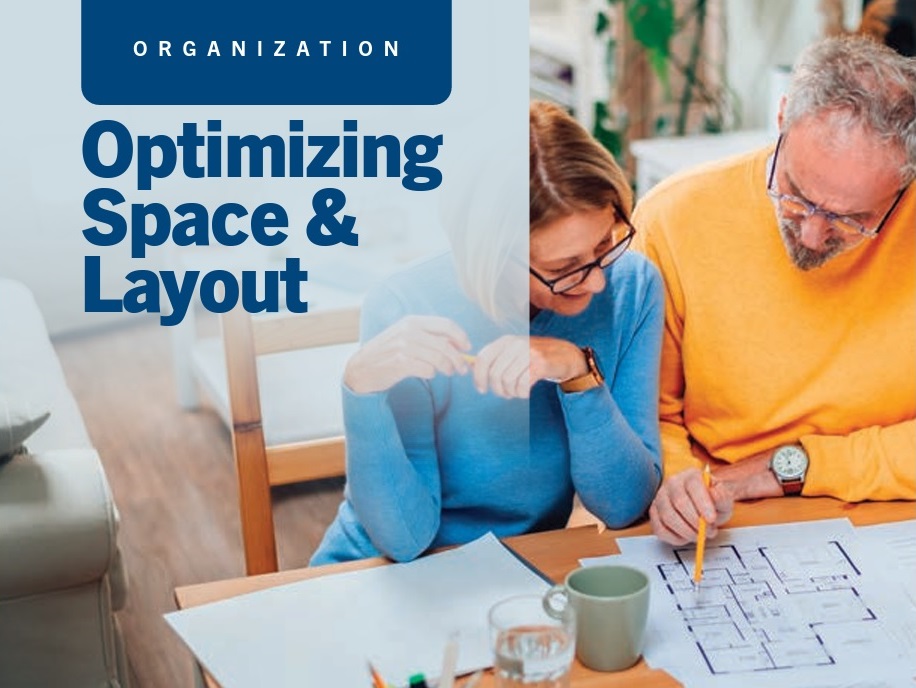
No matter our age, we are always looking to make our home into more functional space. With home organization tactics you can turn any ordinary home into an ideal home. Knowing these strategies can help Utah Seniors optimize their property and can even open up possibilities.
- Keeping Space Free and Clear
Whether your home has large rooms and halls or narrow corners and walkways, keeping spaces free and clear of clutter makes for a safer and more livable home for Utah seniors. Having an understanding of how to keep spaces free of clutter is important:
- Avoid clutter by taking care of paperwork – If you have stacks of bills and receipts then it is a good idea to invest in a filing cabinet, or use an electronic filing system. A binder with important legal documents that contain your birth certificates, home and car deeds, tax returns, and medical records is a good way to keep documents safe and always know where they are when needed. Consider making a list of current medications including your dosages and usage instructions. You can place this list in a convenient easy to spot place, like the fridge, to help remind you.
- Free up space by throwing away unneeded items – more stuff equals more clutter! Keeping only the objects you need makes your space easier to live in and manage. Objects that you may view as essentials might be getting in the way. Think about what are your favorite holiday decorations, old books and movies and only keep your favorites. You can replace oversized furniture with alternatives that are less-bulky which helps makes narrower areas easier to maneuver. Think about where furniture is placed. Is a table in your entryway serving a purpose, or is it making the walkway more narrow? Remember you can open up space by keeping only the objects that serve you.
- Clear walkways by tucking away cords and appliances – Having floor space open and free from clutter will vastly improve the safety and functionality of your space. Think about strategically placing appliances so you’re not unnecessarily crowding walkways. Prioritize decluttering high-traffic areas such as hallways to the kitchen, bedrooms, and bathroom. Secure cords and throw rugs to reduce tripping hazards. Make sure appliances such as washers, dryers, and refrigerators fit in their spaces and have plenty of room for you to use and walk around.
2. Navigating Stairs
Many Utah seniors prefer homes that have limited or no stairs, but avoiding stairs is often not an option. Luckily there are solutions to make living with stairs as an older adult easier and less of a concern. Look at the stair structure, assess proper lighting, and limit the amount of times you need to go up and down are all important steps to making stairs workable for older adults.
- Assess the functionality of the stairs – Not every stairway is created equal. Consider the functionality of the stairs in your home, or home you are looking to buy. Think about how deep or narrow the steps are, and if the stairs have handrails and/or banisters. Are the handrails secure and easy to grasp? Is the stairway wide enough to install a lift or other accessibility aid if you or a loved one needs help accessing the stairs in the future?
- Install lighting to make stairs safer – Better lighting on stairways makes steps easier to see for older adults and helps reduce the risk of falls. Illuminating a stairway can be as simple as installing a brighter light bulb, but make sure you check the wattage limits on your fixtures before making the change. Sometimes installing a new fixture might be the best option so you have plenty of light on the stairway. You can also run lighting on the edges of the stairs, which allow you to see each and every step with more clarity.
- Create a system that limits trips up and down the stairs – One solution is mounting baskets on the wall at the top and bottom of the staircase. You can place items that need to go up or down the stairs in the basket throughout the day. Then, when it’s time to go up the stairs you can take all of the items with you. This also helps eliminate the need to bend and pick up items left on a step, keeps clutter off the floor, and eliminates unnecessary trips up and down the stairs.
3. Optimizing Kitchens and Closets
The majority of your daily use items will be found in the kitchen and closets. It’s important to make the most out of the space to greatly improve the functionality of your home. Eliminating duplicates, installing accessible storage solutions, and making objects easier to reach can vastly improve daily living and improve home functionality.
- Toss unnecessary extras to free up space – If you’ve lived in your home for several years then you know you can often collect more belongings than you actually need. Declutter closets and kitchens by getting rid of items you have duplicates of: an extra potato masher or toaster, cookware you had for when you used to entertain, and your wardrobe with professional clothing are good places to start. Does it make sense to donate old work clothes that you don’t need? Or pass on your china set to your children? Eliminating old clothes and cookware frees up space and makes it easier to store and access the times you actually use.
- Make the space stretch further – Cabinetry, shelving, and storage racks can dramatically change closets and kitchens. Think of the functionality of what is already in your home. Baskets and bins can make it easier to store items on shelves. Pull-out drawers with handles and closet doors that have levers make it easier to access. Taller counters reduce the need to stoop which can cause back pain. Shorter counters can allow shorter people to sit while cooking or cleaning. Installing drop-down rods can double closet space and make clothing easier to reach if you are in a wheelchair.
- Keep daily-use items accessible – Being able to safely reach the times you use regularly is essential as you age. Storing often-used items 3-5 feet off of the ground can be ideal for safe access because it limits the need to stretch or bend. Place a bin on the counter for medicines, reading glasses, TV remote, and other every-day items to keep them contained and easy to find and carry. Purchase a cart with wheels for your kitchen or closet to move food and laundry with more ease and stability, which will help reduce the risk of personal injury or dropping carried objects.
Remember to think: what’s possible in this space? Keeping these tips in mind will optimize space and layout in your home and make living more functional. These tips can free up clutter and make your home easier to navigate and eliminate potential trip and fall hazards. Reach out if you’d ever like more tips or need help identifying areas where you can make your home more organized.
Sorry we are experiencing system issues. Please try again.

